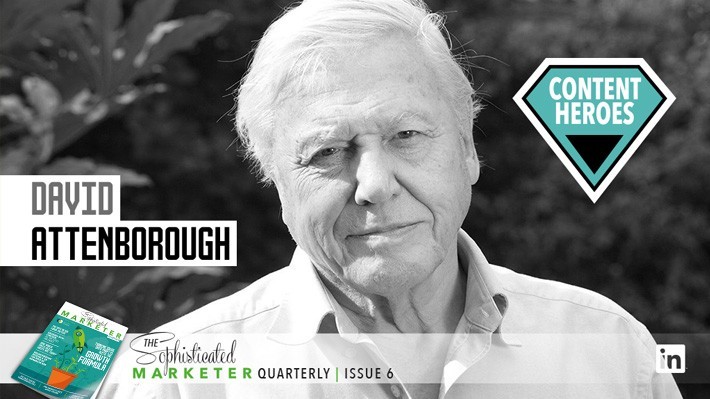Content Heroes: Sir David Attenborough
He’s the UK’s most recognisable and revered national figure, second only to the Queen in his symbolic value for the country. For international TV audiences, he’s the face and voice of the highest-quality natural history filmmaking on earth, perhaps most famous for his Blue Planet films that have focused global attention on the issue of plastic waste. Sir David Attenborough is arguably the greatest and most influential storyteller working in the media today – and yet he never intended to be the one telling the stories.
When I think about content heroes to draw inspiration from, his name has to come close to the top of the list. That’s partly because of the way people of my generation and my parents’ generation have all grown up with him. However, it’s also because of his vision of what content can be.
Sir David pretty much invented TV as most people in the UK understand it today. He didn’t just set new standards in wildlife filmmaking. As Controller of BBC Two during the 1960s, he commissioned shows from Monty Python’s Flying Circus to the iconic sports programme Match of the Day, and the original edgy live music show, The Old Grey Whistle Test. He’s been consistently ambitious when it comes to bringing important ideas to life on screen, and relentlessly creative and innovative in how he sets about doing it. In my mind, he’s pretty much the definition of what a thought leader should be. If you’re a B2B marketer worried about how to communicate complex ideas to your audience, there’s a lot to learn from Sir David’s career, particularly when it comes to video content.
A Content Creator on a Mission
Appearing on camera wasn’t one of this 93-year-old’s career priorities when, two years after leaving national service in the Royal Navy, he applied for a job as a radio producer for the BBC. What mattered to him then, and still does today, is a fascination with the world and a passionate belief that others can and should share that fascination. He has always been a content creator on a mission.
That mission has involved embracing every new storytelling platform and every new media format as it’s emerged. He didn’t start out planning to do this as a famous face on-camera – but as a producer, a writer and an inventor of new ways for film and video could inspire people. It wasn’t personal ambition that turned him into a TV icon; it was how ambitious he was about what content could do.
Creativity with the resources available
He didn’t start out making wildlife programmes with huge budgets. When he came up with the idea for a three-part series called Animal Patterns, he designed the idea around the animals available to film at London Zoo. It was a creative solution to demonstrating interesting concepts in evolutionary biology in an accessible, engaging way – and with whatever resources he had available to him.
Sir David didn’t plan on presenting Zoo Quest, the 1954 series on animal collecting expeditions that first made him famous. His idea was that the series would be presented by one of the zoo’s curators. However, when that curator fell ill, he stepped up to fill the gap. And natural enthusiasm quickly overcame BBC bosses’ concerns that his teeth were too big to appear on camera. Over the next half century, the natural history series that Sir David wrote and presented would explore every facet of life on earth: plants, insects, birds, mammals, oceans and more. He told compelling stories of evolution and the struggle to survive that turned the natural world into part of the national conversation. His set pieces of iguanas escaping snakes or titanic giraffe battles still thrill audiences – and set social media alight – today. It’s hard to imagine the UK and other parts of the world having the same relationship to the natural world without him.
Respect for the audience – and the idea
It’s not just expertise in mass appeal that marks Sir David out, though. It’s always been combined with an unparalleled respect for TV audiences. He’s never ‘dumbed-down’ content or assumed that subject matter is too intellectual for the public as a whole to be interested in it. He’s always seen it as a creative challenge to deliver that content in the most engaging way possible – and in the process, he’s elevated the global conversation.
As he gradually pulls back from presenting series himself, it’s this combination of integrity and creativity that I’d argue should be the real lesson of Sir David’s career. He’s won awards for his work in black and white TV, in colour, in 3D and in ultra-high definition. He’s an innovator who’s never let the innovation get in the way of what he’s trying to communicate. He’s started with ambitious, intellectual concepts, challenged himself to express them clearly and imaginatively, and always risen to the challenge. In the process, he embedded the idea of television not just as a medium for entertainment, but as a channel for ideas. And he remains the embodiment of that concept today.
This post originally appeared as a column in the latest edition of The Sophisticated Marketer Quarterly. You can explore the full issue online now.
Related articles



